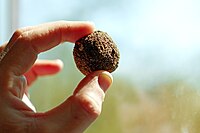
Photo from wikipedia
Achieving multi-million-hectare commitments from countries around the world to restore degraded lands in resilient and sustainable ways requires, among other things, huge volumes of tree planting material. Seed systems encompassing… Click to show full abstract
Achieving multi-million-hectare commitments from countries around the world to restore degraded lands in resilient and sustainable ways requires, among other things, huge volumes of tree planting material. Seed systems encompassing all forest reproductive material (e.g., seeds, cuttings, stakes, and wildings), are key to ensuring that sufficient planting material with a diverse range of suitable species, adapted to local conditions and capable of persisting under a changing climate, is available for restoration projects. The ideal structure of a seed system integrates five components: seed selection and innovation, seed harvesting and production, market access, supply and demand, quality control, and an enabling environment. We propose 15 indicators to evaluate these key components and trial them by assessing national seed systems in 7 Latin American countries. We conclude that the indicators enable a straightforward assessment of the strengths and weaknesses of national seed systems, thus assisting governments to identify key areas for improvement and opportunities for horizontal learning.
Journal Title: Diversity
Year Published: 2021
Link to full text (if available)
Share on Social Media: Sign Up to like & get
recommendations!